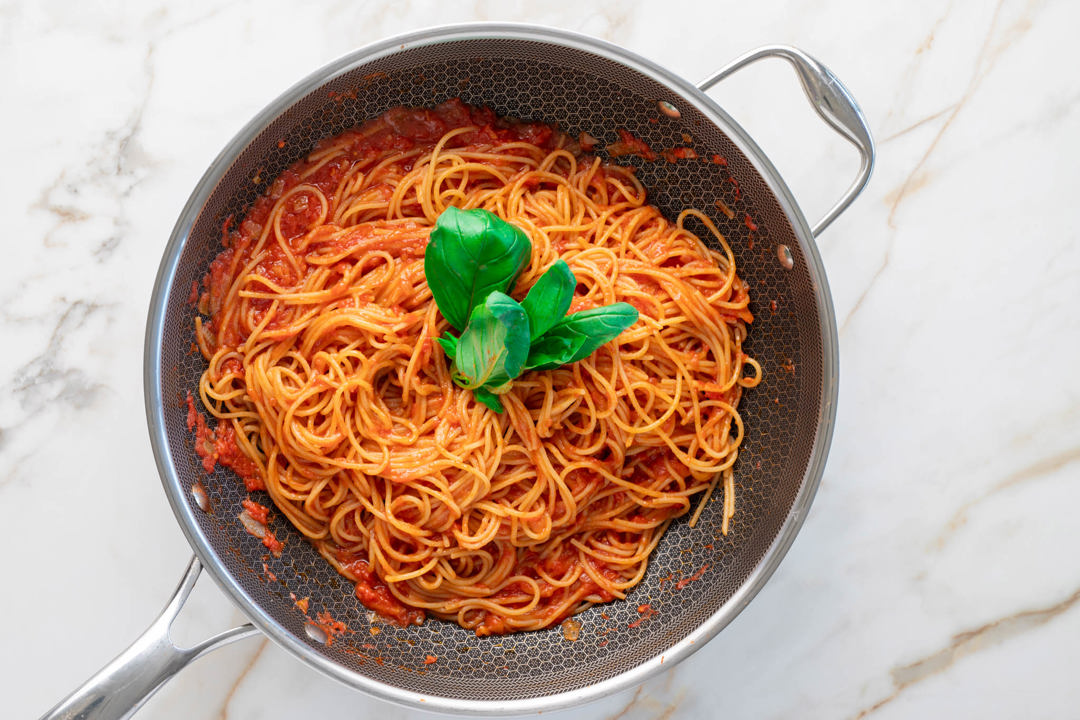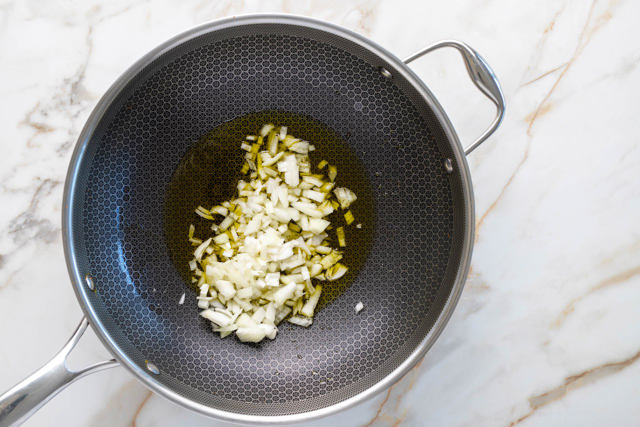Napoletana sauce is an easy to make authentic Italian tomato sauce, perfect for homemade pasta dishes. As with so much Italian food, it's made with humble ingredients prepared in a way that makes them sing together. Made from pantry staples, all you need are canned tomatoes, garlic, onion and herbs to make a Napoletana sauce as good as your local Italian joint.
Napoletana sauce has a few names - you might know it as Napoli, Napolitana, or Marinara sauce. Easy to make, this classic Italian sauce comes together in about 15 minutes, making it ideal for quick weeknight dinners. Napoletana sauce makes a great base for pizza sauce, meatballs and lasagne!
The recipe here is for serving with pasta, but if you want to use it for a pizza or meatballs or whatever else, just don't cook the pasta.
What is Napoletana sauce?
Napoletana sauce is a meatless, tomato based Italian sauce hailing from Naples in southern Italy. It comprises a few simple aromatics which are gently cooked in oil to flavour it, before adding tomatoes to the dish to simmer and thicken.
Napoletana sauce ingredients
- Extra virgin olive oil - we make an infused oil to start with which carries the flavour into the onions.
- Tomato - this is a tomato sauce, so it goes without saying to use the best canned tomatoes you can afford. I really like to use whole tomatoes, just break them up - squish them with your hands - before adding them to the pan. You can use fresh tomatoes, but make sure to remove the skins before cooking.
- Onion - onion is optional, but I like the taste and texture it brings. You can cut it up finely, in which case it mostly melts into the sauce, or you can leave it in large pieces and remove prior to serving, after its infused the oil with its flavour. My recipe includes a small amount of onion, if you don't cook it you'll need to reduce cooking type accordingly.
- Garlic - I like to mince my garlic and add it 30 seconds or so before adding the tomatoes; when it's minced it doesn't take very long to infuse the oil. Always use fresh garlic cloves.
- Basil - as with the onion and garlic, the basil is used to infuse the oil. If you would like a stronger basil flavour, you can finely slice some leaves and stir through once the pasta is cooked.
- Seasoning - salt and sugar. This depends on which type of tomatoes you use. Some canned varieties are already salted and might not need much extra salt. Sugar might not be needed either, it depends on the tartness of your tomatoes. The dish should not taste sweet; the sugar is used to neutralise the acidity from the tomatoes.
How to make Napoletana sauce
Mise en place - Prepare the garlic and onion. If using whole canned tomatoes, crush them.
Heat oil - Add oil to a large pan over medium heat.
Cook onion - When the oil is hot, add the onion to the skillet and start cooking (i). Stir every 30 seconds or so and make sure that the onion is not colouring - reduce the heat if it does. The goal here is to gently soften the onion (ii). If you're not using onion, you can skip this step.
Add garlic and basil - When the onion is tender - after cooking for about 5 minutes - add the garlic and basil.
Cook garlic and basil - After adding the garlic and basil, stir and cook for about a minute until the garlic is fragrant and the basil is wilted.
Add tomato - add the tomato to the pan and stir to combine all ingredients. Reduce heat to medium low and simmer while the pasta cooks.
Cook pasta - start cooking the pasta. Salt the cooking water according to packet instructions and take note of the suggested cooking time for al dente - you want to add the pasta to the sauce when the pasta is slightly firmer than al dente.
Stir sauce - while the pasta is cooking, keep an eye on the sauce. It should be just bubbling away - add a splash of water if it's looking too thin. Stir it occasionally to make sure nothing is sticking on the bottom.
Add pasta to sauce - drain the pasta, ideally using a spider if you have one. Reserve the cooking liquid. Add the pasta to the sauce and using tongs, thoroughly combine the pasta with the sauce. The pasta will pull liquid from the sauce while it continues to cook, so you'll need to add some of the pasta water to the pan while it finishes cooking.
Adjust seasoning - add salt and sugar as needed, and remove the basil sprigs from the sauce.
Serve with a couple of fresh basil leaves and a good grating of parmesan cheese.
Tips
- Tomatoes are the star of the dish, so use the best quality ones you can afford.
- Cook the onions slowly without colouring for the best flavour.
- Don't use jarred garlic - always use fresh garlic.
Why do we finish the pasta in the sauce?
Finishing the pasta in the sauce allows the pasta to pull the flavour of the sauce in, and to use its starch to thicken the sauce. It's only for the last minute of cooking, and it helps the dish to come together.
How much sugar should I use?
This is dependent on the type of tomatoes that you're using. If you're using canned cherry tomatoes you might not need to add any. The sauce should not taste sweet - you're trying to balance the tartness of the tomatoes. Just add a pinch of sugar at a time until you're happy how it tastes.
Can I use fresh tomatoes?
You can use fresh tomatoes - just make sure to peel them first. I wouldn't worry about removing the seeds.
What type of pasta should I use?
This sauce works well with any type of pasta. Give it a try with gnocchi too!
What to do with leftovers?
This sauce freezes well, so you can always double or triple the recipe - but I suggest freezing before you add the pasta. The sauce will last for 3-4 days in the fridge after making.
Where to use Napoletana sauce
Napoletana sauce has a variety of uses. I serve it here with pasta for a simple and quick weeknight meal, but you can use it in many other ways, such as:
- Eggplant parmigiana
- Meatballs in tomato sauce
- Pizza sauce
- Chicken parmigiana
- Baked ziti
You can also substitute the pasta with gnocchi for a twist!

Napoletana sauce
| Prep | Cook | Total |
|---|---|---|
| 5 mins | 15 mins | 20 mins |
- 80ml (approx. 1/3 cup) extra virgin olive oil
- 1 medium onion, finely diced see note 1
- 4 cloves of garlic, minced see note 2
- 2 sprigs of basil leaves and stems
- 800g canned tomatoes see note 3
- Salt, to taste and season the pasta water
- Sugar see note 4
- 400g pasta of choice
- Parmigiano Reggiano, grated, to serve aka parmesan cheese
- Basil leaves sliced or whole - whatever works for you
- Heat oil - heat oil in a large skillet over medium heat.
- Cook onion - when the oil is hot, add the onion and slowly cook it, and start boiling your pot for the pasta. If the onion starts to colour, reduce the heat - you want to cook the onion until it is tender and without colour, which will take about 5 minutes.
- Add garlic and basil and stir to combine, cooking for about a minute until the garlic is fragrant and the basil wilted.
- Add the tomato and bring to a simmer, then reduce heat to medium low, so it is gently simmering. Stir occasionally to make sure nothing is sticking. The tomato needs to simmer for about 10 minutes, so get started on your pasta now. Do keep an eye on the sauce and add a splash of water if it dries out too much.
- Cook pasta - start cooking your pasta according to packet instructions, but strain just before al dente - reserving the pasta liquid when you do.
- Add pasta to the sauce and use tongs to thoroughly incorporate with the sauce. Because the pasta is still cooking, it will pull liquid from the sauce - add 1/4 cup of the reserved pasta water at a time to loosen the sauce as required.
- Season with salt and sugar. The sauce should not taste sweet, but likewise acidity or tartness from the tomatoes should not be present. Add small amounts of salt and sugar and taste as you go - remember the pasta water is salty. Remove the cooked basil sprigs from the sauce.
- Serve with some fresh basil leaves and a good grating of Parmigiano Reggiano or parmesan cheese.
- Onions - I like to dice my onion finely, but others may prefer to remove it prior to serving. If so, halve the onion and then cut into large wedges which you'll be able to remove before serving. You can also skip the onion entirely, in which case skip the second step and add the garlic and basil.
- Garlic - adjust garlic to suit your own preferences but this is reasonable to me. Always use fresh cloves, never the jarred stuff.
- Canned tomatoes - use whichever type of tomato you like. If using whole canned tomatoes, crush them with your hand in a bowl before adding to the pan. If you use fresh tomatoes, remove the skin before making the sauce.
- Sugar - if your tomatoes are not sweet, you'll need to add a little sugar to offset the tartness and acidity of the tomatoes. The sauce should not taste sweet, but it shouldn't taste tart or acidic either. Add the sugar slowly and taste while you're going.





























